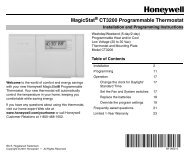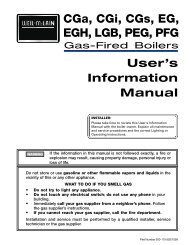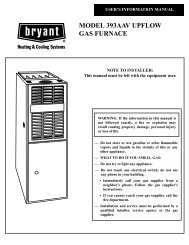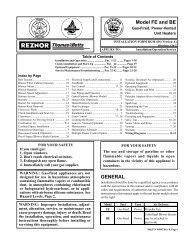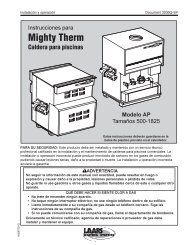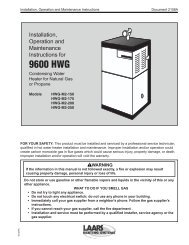Power Vented Gas Models FPSH/FPCR/FPST with ... - Geisel
Power Vented Gas Models FPSH/FPCR/FPST with ... - Geisel
Power Vented Gas Models FPSH/FPCR/FPST with ... - Geisel
You also want an ePaper? Increase the reach of your titles
YUMPU automatically turns print PDFs into web optimized ePapers that Google loves.
through the drain in the bottom of the housing. A plastic tube<br />
is furnished for the condensate to be drained away from the<br />
water heater.<br />
A method to keep the condensate from draining back to the<br />
blower, in a horizontal run, is to install the pipe <strong>with</strong> a slight<br />
downward slope. The pipe can slope 1/4 inch per five (5) feet<br />
of pipe, but no more than 1.5 inches in the total vent length.<br />
The vent system should be supported every five(5) feet of<br />
vertical run and every three (3) feet of horizontal run of vent<br />
pipe length. All pipe and fittings should be joined by the proper<br />
procedures discussed on pages 11 and 12, under the heading:<br />
VENT PIPE PREPARATION.<br />
VERTICAL VENT THROUGH ROOF<br />
This unit is approved for venting through the roof <strong>with</strong> only the<br />
vent terminal that is included <strong>with</strong> the unit. All proper flashing or<br />
“BOOT” should be used to seal the pipe where it exits the roof.<br />
The total vent system should not exceed that which is specified in<br />
the chart on page 9.<br />
All of the pipe should be secured as per the instructions in the<br />
“INSTALLATION OF VENT SYSTEM” on pages 8 and 9.<br />
VERTICAL VENT TERMINATION RESTRICTIONS<br />
1. Minimum of twelve (12) inches above the roof or twelve (12)<br />
inches above the anticipated snow level. Provide proper<br />
support for all pipe protruding through the roof.<br />
2. Four (4) feet from or one (1) foot above any gable, dormer, or<br />
other roof structure <strong>with</strong> access to interior of building (i.e.-vent,<br />
window etc.).<br />
3. Three (3) feet above any forced air inlet located <strong>with</strong>in ten (10)<br />
feet.<br />
FIGURE 8<br />
10<br />
VENT PIPE PREPARATION<br />
1. INITIAL PREPARATION<br />
A. Make sure the solvent cement you are planning to use is<br />
designed for the specific application you are attempting.<br />
B. Know the physical and chemical characteristics and<br />
limitations of the PVC and CPVC piping materials that<br />
you are about to use.<br />
C. Know the reputation of your manufacturer and their<br />
products.<br />
D. Know your own qualifications or those of your contractor.<br />
The solvent welding technique of joining PVC and CPVC<br />
pipe is a specialized skill just as any other pipe fitting<br />
technique.<br />
E. Closely supervise the installation and inspect the finished<br />
job before start-up.<br />
F. Contact the manufacturer, supplier, or competent<br />
consulting agency if you have any questions about the<br />
application or installation of PVC and CPVC pipe.<br />
G. Take the time and effort to do a professional job.<br />
Shortcuts will only cause you problems and delays in<br />
start-up. By far, the majority of failures in PVC and CPVC<br />
systems are the result of shortcuts and/or improper<br />
joining techniques.<br />
2. SELECTION OF MATERIALS<br />
Cutting Device - Saw or Pipe Cutter<br />
Deburring Tool, Knife, File, or Beveling Machine (2" and<br />
above)<br />
Brush - Pure Bristle<br />
Rag - Cotton (Not Synthetic)<br />
Primer and Cleaner<br />
Solvent Cement - PVC for PVC Components and CPVC for<br />
CPVC Components<br />
Containers - Metal or Glass to hold Primer and Cement .<br />
Select the type of PVC or CPVC materials to be used on<br />
the basisof their application <strong>with</strong> respect to chemical<br />
resistance, pressure rating, temperature characteristics, etc.<br />
Insertion Tool - Helpful for larger diameter pipe and fittings<br />
(6" and above).<br />
PRIMER<br />
It is recommended that Tetrahydrofuran (THF) be used to prepare<br />
the surfaces of pipe and fittings for solvent welding. Do not use water,<br />
rags, gasoline or any other substitutes for cleaning PVC or CPVC<br />
surfaces. A chemical cleaner such as MEK may be used.<br />
CEMENT<br />
The cement should be a bodied cement of approximately 500 to<br />
1600 centipoise viscosity containing 10-20% (by weight) virgin<br />
PVC material solvated <strong>with</strong> tetrahydrofuran (THF). Small quantities<br />
of dimethyl formamide (DMF) may be included to act as a retarding<br />
agent to extend curing time. Select the proper cement; Schedule<br />
40 cement should be used for Schedule 40 pipe. Never use allpurpose<br />
cements, commercial glues and adhesives or ABS<br />
cement to join PVC or CPVC pipe and fittings.<br />
SAFETY PRECAUTION: PRIMERS AND CEMENTS ARE<br />
EXTREMELY FLAMMABLE, AND MUST NOT BE STORED OR<br />
USED NEAR HEAT OR OPEN FLAME. ALSO, USE ONLY IN A<br />
WELL-VENTILATED AREA.



